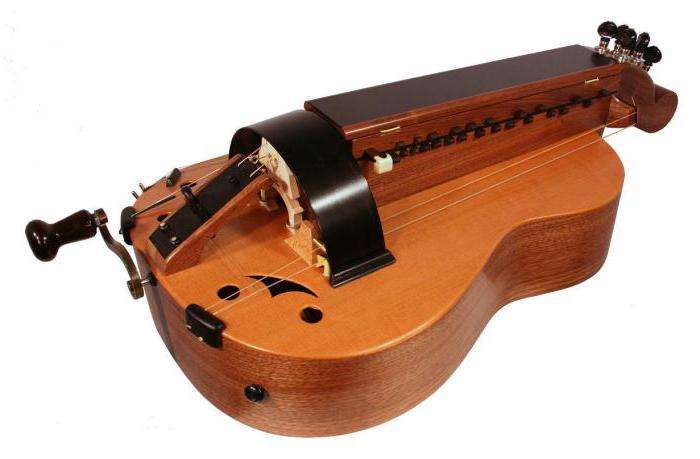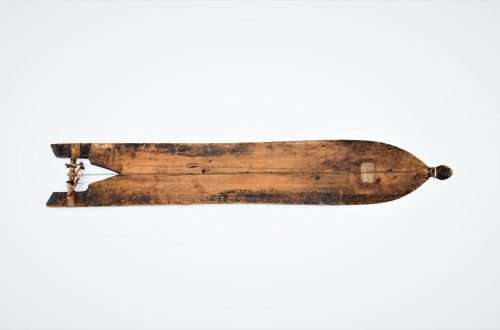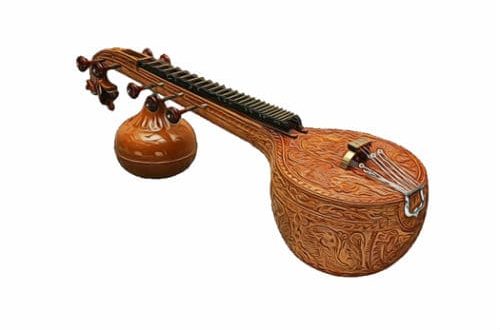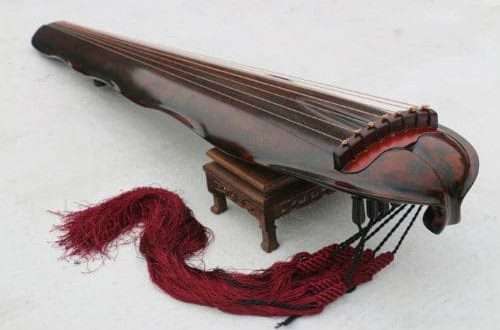
Wheel lyre: description of the instrument, composition, sound, history, use
Contents
The hurdy gurdy is a musical instrument from the Middle Ages. Belongs to the category of string, friction. The closest “relatives” are the organist, nikelharpa.
Устройство
The tool looks quite unusual, among its main components are the following:
- Frame. Made of wood, shaped like the number 8. Consists of 2 flat decks fastened with a wide shell. At the top, the body is equipped with a peg box and holes that act as resonators.
- Wheel. It is located inside the body: it is planted on an axis, which, bypassing the shell, is connected to a rotating handle. A part of the wheel rim protrudes from the upper deck through a special slot.
- Keyboard mechanism. Located on the top deck. The box includes 9-13 keys. Each key has a protrusion: when pressed, the protrusions touch the string – this is how the sound is produced. The projections can be rotated by moving left and right, thus changing the scale.
- Strings. The initial quantity is 3 pieces. One is melodic, two are bourdon. The middle string is inside the box, the rest are outside. All the strings are connected to the wheel: rotating, it extracts sounds from them. The main melody is played by pressing the keys: by touching the string in different places, the protrusions change its length, and at the same time the pitch.
Initially, the material of the strings was animal veins, in modern models they are made of metal, nylon, their number differs from medieval samples (in a big way).
What does a hurdy gurdy sound like?
The sound of the instrument largely depended on the quality of the wheel: the accuracy of its centering, the smoothness of the surface. For harmony, purity of the melody, the surface of the wheel was smeared with rosin before playing, the strings were wrapped in wool at the point of contact with the wheel.
The standard sound of the hurdy-gurdy is sad, slightly nasal, monotonous, but powerful.
History
The predecessor of the hurdy-gurdy was the organistrum, a large and heavy instrument, an inconvenient instrument that only a couple of musicians could handle. In the X-XIII centuries, the organistrum was present in almost every temple, monastery – sacred music was performed on it. The oldest depiction of the organistrum on an English miniature dates back to 1175.
The hurdy gurdy quickly spread throughout Europe. The smaller version became popular among vagrants, the blind, and beggars who performed tunes for the public to subsist on.
A new round of popularity overtook the instrument in the XNUMXth century: the aristocrats drew attention to an old curiosity and put it into use again.
The lyre appeared in Russia in the XNUMXth century. Presumably, it was imported from Ukraine, where it was extremely popular. There were special educational institutions that taught Ukrainians to play the instrument.
In the USSR, the hurdy gurdy was improved: the number of strings was increased, enriching the sound, a transmission tape was installed instead of the wheel, and a device was added that changed the pressure on the string.
To meet today this instrument is a rarity. Although it still sounds successfully in the State Orchestra of Belarus.
Play technique
The performer puts the structure on his knees. Some tools are equipped with straps for greater convenience – they are thrown over the shoulders. An important point is the position of the body: the peg box is located on the left hand of the musician, slightly deviates to the side so that the keys do not press on the string.
With the right hand, the performer slowly rotates the handle, setting the wheel in motion. The left hand works with the keys.
Some musicians perform melodies while standing. This position during the Play requires much more skill.
Other titles
The hurdy gurdy is the modern, official name of the instrument. In other countries, its name sounds differently:
- Drehleier. One of the German names. Also, the instrument in Germany was called “betterleier”, “leier”, “bauernleier”.
- Ryla. The Ukrainian name for the lira, which experienced incredible popularity among the local population at the turn of the XNUMXth-XNUMXth centuries.
- Vielle. The French “name” of the lyre, and far from the only one. She was also called “vierelete”, “sambuca”, “chifonie”.
- Hurdy-gurdy. The English name used by Russian performers sounds like “hardy-hardy”.
- Ghironda. Italian variant. Also in this country, the words “rotata”, “lira tedesca”, “sinfonia” are applicable to the lira.
- Tekero. under this name, the inhabitants of Hungary know the lira.
- Lira korbowa. This is the name of the instrument in Polish.
- Ninera. under this name there is a lira in the Czech Republic.
Using the tool
The primary role of the instrument is accompaniment. They danced to the sounds of digging, sang songs, told fairy tales. Modern performers have expanded this list. Despite the fact that today the popularity of the hurdy-gurdy is not as great as in the Middle Ages, musicians of folk, rock bands, jazz ensembles include it in their arsenal.
Among our contemporaries, the following celebrities used the improved lyre:
- R. Blackmore – British guitarist, leader of the Deep Purple band (Blacrmore’s Night project).
- D. Page, R. Plant – members of the group “Led Zeppelin” (project “No Quarter. Unledded”).
- “In Extremo” is a popular German folk metal band (song “Captus Est”).
- N. Eaton is an English organ-grinder who also plays the hurdy-gurdy.
- “Pesnyary” is a vocal and instrumental ensemble of the Soviet period, including musicians of Russian, Belarusian origin.
- Y. Vysokov – soloist of the Russian rock band “Hospital”.
- B. McCreery is an American composer, he wrote soundtracks for the TV series Black Sails, The Walking Dead with the participation of a hurdy-gurdy.
- V. Luferov is a Russian musician who plays solo works on this instrument.
- Kaulakau are four Spanish folk-jazz musicians.
- Eluveitie is a Swiss folk metal band.
- “Omnia” is a musical group with a Dutch-Belgian composition, composing works in the folk style.





